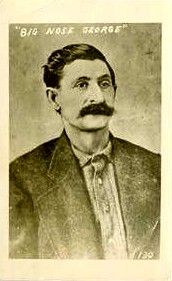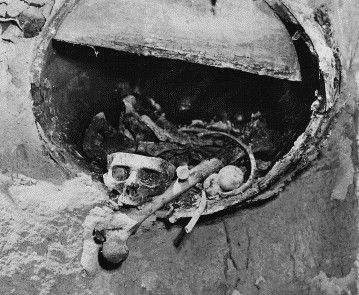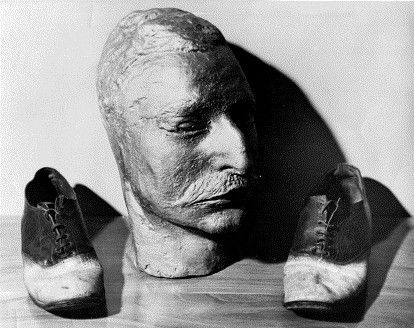|
THIS
COUNTY IS OPEN FOR ADOPTION.
IF
YOU WOULD LIKE TO ADOPT IT, PLEASE CONTACT THE STATE
COORDINATOR
If you have any information to share
about Carbon County Wyoming please feel free to email me:
Rebecca
Maloney
Big Nose George



George Parrot,
also known as George Francis Warden, George
Manuse, and Big Nose George, is infamous not
only for being hanged as an outlaw but also
for being the only man in American history
who became a pair of shoes after his death.
The outlaw, known
for his large nose and thusly most often
called “Big Nose George,” was a member of a
gang of road agents and horse thieves.
Led by a man named
Sim Jan, the outlaws were active in the
Powder River country of Wyoming, robbing pay
wagons and stagecoaches of cash shipments
and relieving passengers of their money and
jewelry. The gang was also comprised of
members, Frank McKinney, Joe Manuse, Jack
Campbell, John Wells, Tom Reed, Frank Tole,
and Dutch “Charley” Burress.
On August 16,
1878, the road agents planned to rob a Union
Pacific train near Medicine Bow by
manipulating the tracks so that the train
would derail. However, as seven of the
outlaw members hid in the brush waiting for
the train to arrive, a section crew came
along and discovered the tampered rail.
Reportedly, Frank
McKinney wanted to shoot them, but Big Nose
George and Frank Tole objected, saying they
hadn’t come to kill section men. Meanwhile,
as the crewman repaired the track, a
railroad foreman rode ahead to stop the
approaching train and informed the law that
the rails had been tampered with. Their plan
thwarted, the outlaws could do nothing but
silently watch as the track was repaired,
then after the workers left, rode off.
In no time, a
posse was sent to apprehend the would-be
train robbers. Two lawmen soon tracked the
gang to Rattlesnake Canyon at Elk Mountain,
where the outlaws shot and killed them.
Afterward, the gang split up, heading in
various directions. After discovering the
two dead
lawmen, the Union Pacific Railroad doubled
their efforts in tracking the murderers and
county authorities offered a $10,000 reward
for their capture.
Frank Tole was
killed the next month while trying to rob
the Black Hills Stage Line.
Dutch Charlie was
the first to be apprehended in 1879, but
when the westbound train was bringing the
outlaw to Rawlins for trial, it was stopped
by a mob in Carbon. Dutch Charlie was then
forcibly taken from the train and hanged
from a telegraph pole.
Later, when Big
Nose George was in Miles City, Montana, he
got drunk and boasted of the attempted train
robbery and murders in Wyoming. In no time,
a telegraph was sent to Rawlins and in July
1880, Sheriff Rankin of Carbon County went
to Montana to take George back to Wyoming.
Again, as the train made its journey, it was
stopped in Carbon by the same mob that had
lynched Dutch Charlie. Big Nose was hauled
off the train and was prepared for lynching.
However, when the outlaw began to plead for
his life and confessed, promising to tell
all he knew about the murders if they would
let him live, the vigilantes cut him down.
Big Nose was then allowed to continue the
journey to Rawlins to stand trial.
While Parrot was
in jail, he said that Frank McKinney claimed
to be Frank James, which led to the
speculation that Frank McKinney and the
gang’s leader, Sim Jan, were none other than
Frank and Jesse James. McKinney, Jan, and
the rest of the gang disappeared and were
not apprehended.
At George’s trial,
he was found guilty on December 15, 1880,
and was sentenced to hang on April 2, 1881.
However, George didn’t plan to go so easily
and attempted to escape on March 22nd of the
next year. When he attacked Jailer Robert
Rankin, he fractured his skull and cut his
scalp in the process. However, the day was
saved when Mrs. Rankin appeared with a
pistol in her hand and
Big Nose George
was forced back to his cell.
When the news of
the attempted escape spread throughout the
city, a masked mob soon formed and stormed
the jail.
With lynching on
their minds, they dragged Parrot from the
jail to a telegraph pole on what is now
Front Street. As a crowd of about 200 people
gathered, the vigilantes severely botched
the first two hanging attempts, but on the
third try, Big Nose George died at the end
of a rope.
The body was left
hanging for several hours until the
undertaker removed it. Having no family to
claim the corpse, Doctors Thomas Maghee and
John Osborne took possession of it, in order
to study the outlaw’s brain to determine if
there might be a reason for his criminal
behavior. Also on hand was a 15-year-old
Lillian Heath who was working as an
assistant to Dr. Maghee.
After the skull
cap was crudely sawed off, the doctors
examined it and found no marked differences
between Parrot’s brain and a “normal” one.
Though Dr. Maghee and assistant, Heath,
acted within the medical ethics of the time,
Dr. Osborne’s activities soon began to get
very bizarre.
Osborn first
molded a death mask of George’s face using
plaster of paris. The mask was without ears
because while George struggled at the end of
the rope, his ears wore torn off.
Next, Osborn
removed the skin from the dead man’s thighs
and chest, which the doctor sent to a
tannery in Denver with a set of very strange
instructions. The tannery was to use the
skin, including the dead man’s nipples, to
make him a pair of shoes and a medicine bag.
When Dr. Osborn received the shoes, he was
disappointed to find they didn’t include the
nipples, but proudly began to wear them
anyway.
The rest of
George’s dismembered body was kept in a
whiskey barrel filled with a salt solution
for about a year.
Osborn continued
his dissection and experiments for a time
when finally the whiskey barrel and the
outlaw’s remains were buried in the yard
behind Dr. Maghee’s office.
Despite the
doctor’s odd behavior in the desecration of
George Parrot’s body, he soon became
prominent in local politics. In 1892, the
doctor was elected as the first Democratic
Governor of the State of Wyoming and was
said to have worn the shoes at his inaugural
ball in 1893. Later Osborn would become the
Assistant Secretary of State under President
Wilson.
Somewhere along
the line, the skull cap was given to the
young Miss Health, who would later become
the first female doctor in the State of
Wyoming. Over the years, the skull cap was
said to have serviced as an ashtray and a
doorstop in her office.
The incident was
all but forgotten until May 11, 1950, when
construction workers excavating for a new
building on Cedar Street, unearthed a
whiskey barrel filled with bones. The
location was behind the building that had
served as Dr. Maghee’s office years before.
Inside the barrel were numerous human bones
including a skull with the top sawed off.
In no time, as a
crowd gathered to look at the grisly
remains, someone remembered that Dr. Lillian
Heath had kept the skull cap. While well
into her eighties, Heath was still alive and
she was immediately contacted. When her
husband brought the skull cap to the scene
it fit perfectly with the skull found in the
barrel. Though locals were convinced these
were the remains of Big Nose George,
subsequent DNA testing verified the results.
Today, the Carbon
County Museum in Rawlins, Wyoming, proudly
displays Big George’s death mask, his skull,
and the infamous shoes made of the outlaw’s
skin. Also on display is a watch given by
the County Commissioners to Rosa Rankin for
having stopped Big Nose George from escaping
from jail in 1881. The museum is one of the
biggest attractions in the city.
The shackles used
on Big Nose during his hanging and the skull
cap and are on display at the Union Pacific
Museum in Omaha, Nebraska.
The rest of
Parrot’s remains were allegedly secretly
buried years ago in an unknown location. The
medicine bag made of his tanned skin has
never been found.
Do
you have information you'd like to share? Or would you
like to help us?
Please
volunteer
to help the WYGenWeb Project.
The
WyGenWeb Project
Colleen
Pustola,
State Coordinator
Rebecca
Maloney,
Assistant State Coordinator
AVAILABLE
– County
Coordinator
Being
a County or State Administrator is fun and rewarding. If you
have an interest in the history of Wyoming and the genealogy
of it's residents please consider it. If you think "there
is no way I can do this" there are many people ready,
willing and able to help you. It's not near as difficult as
you might think.
|